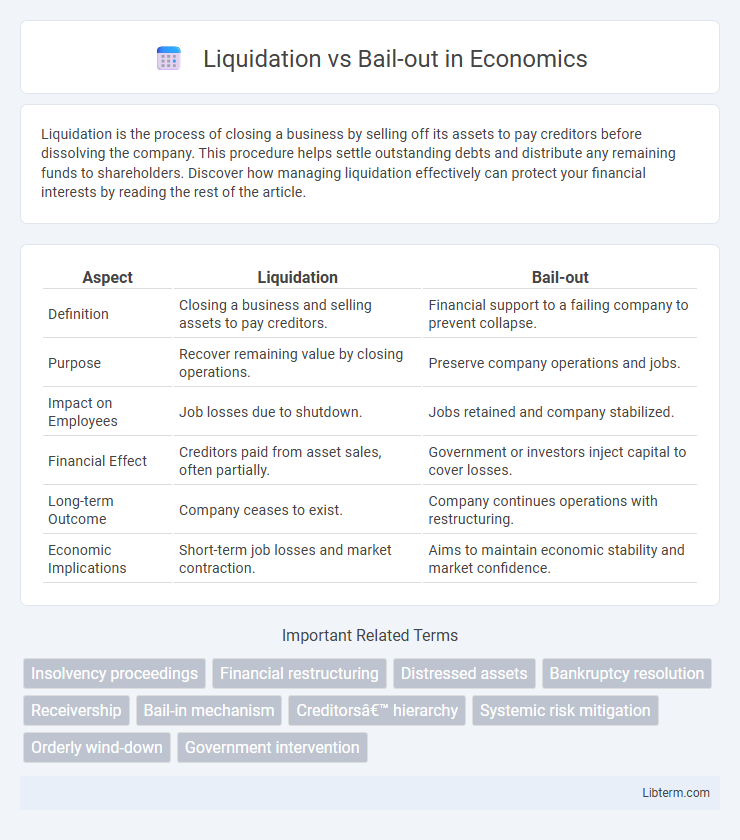Liquidation is the process of closing a business by selling off its assets to pay creditors before dissolving the company. This procedure helps settle outstanding debts and distribute any remaining funds to shareholders. Discover how managing liquidation effectively can protect your financial interests by reading the rest of the article.
Table of Comparison
| Aspect | Liquidation | Bail-out |
|---|---|---|
| Definition | Closing a business and selling assets to pay creditors. | Financial support to a failing company to prevent collapse. |
| Purpose | Recover remaining value by closing operations. | Preserve company operations and jobs. |
| Impact on Employees | Job losses due to shutdown. | Jobs retained and company stabilized. |
| Financial Effect | Creditors paid from asset sales, often partially. | Government or investors inject capital to cover losses. |
| Long-term Outcome | Company ceases to exist. | Company continues operations with restructuring. |
| Economic Implications | Short-term job losses and market contraction. | Aims to maintain economic stability and market confidence. |
Introduction to Liquidation and Bail-out
Liquidation involves the process of closing a company by selling its assets to pay off creditors, typically happening when a business is insolvent and cannot meet its financial obligations. Bail-out refers to the financial support provided to a failing company or country by external parties, such as governments or investors, aimed at preventing collapse and restoring stability. Both strategies are crucial in corporate finance for managing distressed entities but serve different purposes: liquidation ends operations, while bail-outs attempt to preserve them.
Defining Liquidation: Process and Purpose
Liquidation is the process of winding up a company's financial affairs by selling its assets to repay creditors and distribute any remaining funds to shareholders. This procedure brings the company to an end, ensuring orderly settlement of debts and legal compliance. The primary purpose of liquidation is to resolve insolvency by converting assets into cash and closing the business.
Understanding Bail-out: Mechanisms and Goals
A bail-out involves financial support provided by governments or institutions to prevent a failing company or economy from collapsing, aiming to stabilize the market and protect jobs. Mechanisms include capital injections, loans, or guarantees designed to enhance liquidity and restore confidence. The primary goal is to maintain economic stability and avoid the broader negative impacts of a liquidation, which entails selling off assets to pay creditors and typically leads to business closure.
Key Differences Between Liquidation and Bail-out
Liquidation involves the process of selling a company's assets to pay off creditors when the business is insolvent, resulting in its closure, whereas a bail-out provides financial support to keep the company operational and avoid bankruptcy. Key differences include liquidation leading to asset distribution and business termination, while a bail-out aims to restore financial stability and preserve jobs. Liquidation typically benefits creditors through asset recovery, whereas bail-outs may involve government or investor intervention to sustain the company's long-term viability.
Financial Implications for Stakeholders
Liquidation results in asset sales to repay creditors, often leading to significant losses for shareholders and unsecured creditors due to lower recovery rates. Bail-outs provide financial support to struggling companies, preserving business operations and maintaining stakeholder value, though taxpayers or investors in government interventions may face risks. Both approaches present distinct implications for creditor hierarchy, shareholder equity, and overall market confidence.
Impact on Employees and Management
Liquidation leads to job losses as employees are typically laid off when a company ceases operations, causing financial hardship and uncertainty. Management often loses control and may face reputational damage or legal consequences during the winding-up process. In contrast, a bail-out aims to preserve jobs by providing financial support, allowing management to retain operational control and stabilize the company's workforce.
Legal and Regulatory Considerations
Liquidation involves the formal legal process of dissolving a company under insolvency laws, requiring court approval and compliance with creditor protection regulations. Bail-outs are often subject to regulatory scrutiny to prevent market distortions and may involve government intervention under specific legal frameworks designed to stabilize financial institutions. Both processes must adhere to jurisdiction-specific insolvency and financial regulations to ensure lawful resolution and creditor fairness.
Examples of Liquidation and Bail-out Cases
General Motors' 2009 bankruptcy represents a notable example of liquidation where the company shed assets and restructured under court supervision. The U.S. government's 2008 Troubled Asset Relief Program (TARP) provided a significant bail-out to financial institutions like CitiGroup, aiming to stabilize the economy without forcing asset liquidation. Similarly, Lehman Brothers' 2008 collapse illustrates liquidation, while the European Union's bail-out of Greece in 2010 highlights state intervention to prevent economic failure without corporate dissolution.
Pros and Cons of Liquidation vs. Bail-out
Liquidation involves selling a company's assets to pay creditors, ensuring complete closure but often resulting in significant financial loss for stakeholders and potential job redundancies. Bail-out provides financial support to stabilize the company, preserving jobs and business operations, though it may lead to increased debt and dependency on external funding. Choosing between liquidation and bail-out depends on factors like the company's long-term viability, creditor interests, and the economic impact on employees and stakeholders.
Choosing the Right Path: Factors to Consider
Choosing between liquidation and bail-out hinges on a thorough assessment of a company's financial health, market conditions, and stakeholder interests. Key factors include cash flow sustainability, asset liquidity, potential for business recovery, and creditor willingness to negotiate restructuring terms. Evaluating long-term viability versus immediate loss mitigation drives the decision toward either dissolving assets or securing external funding to preserve operations.
Liquidation Infographic

 libterm.com
libterm.com